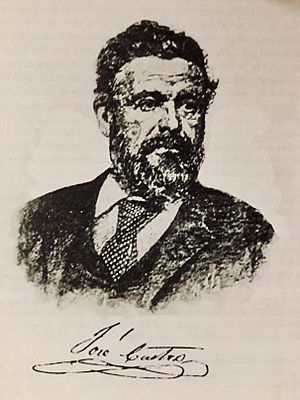José Castro facts for kids
Quick facts for kids
José Castro
|
|
|---|---|
 |
|
| Interim Governor of Alta California | |
| In office 29 September 1835 – 1 January 1836 |
|
| Appointed by | José Figueroa |
| Preceded by | José Figueroa |
| Succeeded by | Nicolas Gutiérrez |
| Governor of Baja California | |
| In office 1853–1860 |
|
| Personal details | |
| Born |
Jose Antonio Maria de Jesus Castro
1808 Monterey, Alta California, New Spain (now California, U.S.) |
| Died | February 1860 (aged 51-52) Baja California, Mexico |
| Resting place | Carmel Mission Cemetery, Carmel-by-the-Sea, California |
| Profession | Soldier, statesmen |
| Military service | |
| Allegiance | |
| Branch/service | Cavalry |
| Rank | Lieutenant Colonel |
| Battles/wars | Battle of Providencia Revolution of 1836 |
José Antonio Castro (1808-1860) was an important leader in California's history. He was a politician, a statesman, and a general. He even served as a temporary governor of Alta California (which is now part of California, USA) and later as governor of Baja California (which is now part of Mexico). During the time when California was becoming part of the United States, Castro was a top general for the Mexican forces in Northern California.
Contents
José Castro's Early Life and Career
José Castro was born in Monterey, California, in 1808. At that time, California was under Spanish rule. His family, known as Californios, had lived there for a long time. His father, José Tiburcio Castro, was a soldier and also helped manage Mission San Juan Bautista.
As a young man, Castro strongly believed that California should govern itself. He wanted it to be fully independent from Mexico. His first public job was as a secretary for the Monterey ayuntamiento (town council). In 1830, he was arrested because he disagreed with the Mexican governor of Alta California. By 1835, he was a main member of the legislature and served as acting governor. He worked with his brother-in-law, Juan Bautista Alvarado, to support California-born governors. They wanted Alta California to have a special, almost independent, status.
Rebellions and Leadership
A long time passed when Mexico City didn't pay much attention to California. They often sent governors who caused problems. In 1836 alone, six different leaders took office in Monterey! In November 1836, Castro helped lead a rebellion to remove the new Mexican Governor Nicolás Gutiérrez.
After talks, the rebellion ended, and Alvarado became the official governor from 1837 to 1842. Castro served under Alvarado as a Lieutenant-Colonel in the militia. He was also appointed as a main member of the legislature and a leader for the Monterey area.
In 1839, Governor Alvarado gave Castro Rancho San Justo. This land included the area around Mission San Juan Bautista. This happened after the Mexican government took control of the missions in 1833 and allowed former mission lands to be privately owned. Castro built an adobe house on San Juan Bautista Plaza in 1841. He used this house for his military work and as a home for his secretary.
In 1844–45, Castro led another revolt against Governor Manuel Micheltorena. After this, he became the Commandante General (top general) under the new governor, Pio Pico.
The Conquest of California
During the Bear Flag Revolt in 1846 and the American Conquest of California that followed, Castro was the commanding general of Alta California's forces. This was during the Mexican–American War. When California joined the United States in August 1846, Castro moved to Baja California and lived in Sinaloa. He returned to Alta California in 1848.
Life After the Conquest
In February 1848, after the Mexican–American War ended, José Castro allowed an Irish settler named Patrick Breen to live in his adobe house in San Juan Bautista. The Breen family were survivors of the Donner Party. They arrived in San Juan Bautista almost a year after their very difficult journey over the Sierra Nevada mountains. The Breens were the first English-speaking Americans to live in the town. Castro let them stay in his house until one of Patrick Breen's teenage sons made a lot of money as a gold miner. This son then bought the house from Castro in 1854.
Castro left California for Baja California in 1853. There, he was appointed governor and military commander. José Castro never gave up his Mexican citizenship or his military rank. In February 1860, Castro died in an incident involving Manuel Márquez.
Legacy
San Francisco's Castro Street and the Castro District are named after José Castro.
The José Castro House in San Juan Bautista is a National Historic Landmark. This means it's a very important historical place. The town of San Juan Bautista was even called San Juan de Castro for a short time in the 1830s. This was because Castro's family was very important in that town.
Images for kids
-
The José Castro House in San Juan Bautista was built between 1839 and 1841. The town was briefly known as San Juan de Castro in the 1830s because of his family's importance there.
-
The Castro District in San Francisco is named for José Castro.
See also
 In Spanish: José Castro (político) para niños
In Spanish: José Castro (político) para niños



